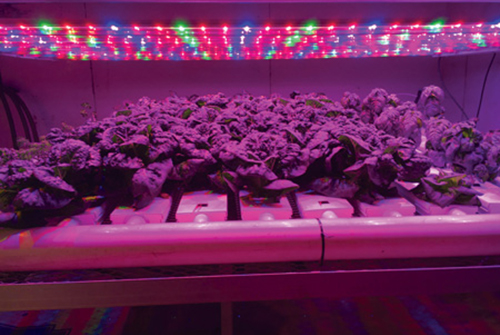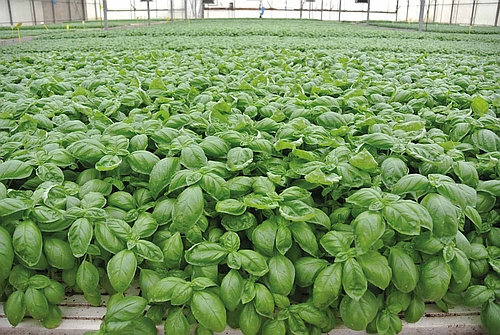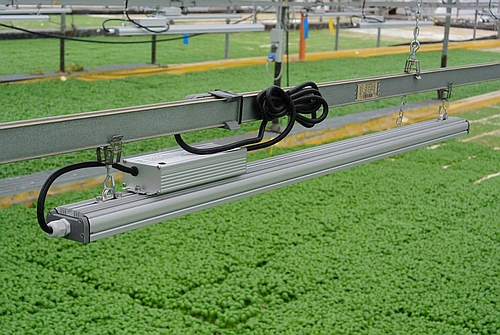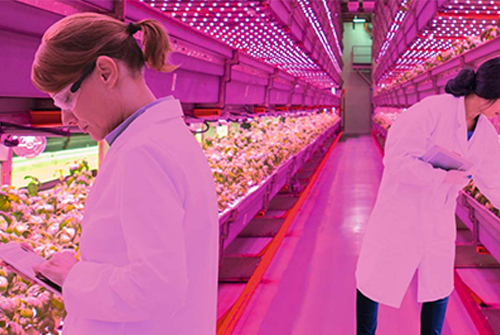Horticultural LED Lighting
Benefits of Horticultural LED Lighting

LED-based horticultural lighting is on the rise. People who will be using this lighting will need education on how to select the optimal fixtures for the projects. Here is your guide to navigating spec sheets and performance calculations for best results.
The future population is estimated to grow to 10 billion by 2050. There are growing concerns about energy, food availability and water for such a high number of people. To produce enough food to feed our fellow human residents and maintain our current water supply, several different practices must be adopted within the agricultural sector. One potential fix to the issue is growing vegetables in water through aquaponics, hydroponics, or aeroponics. LED-based horticultural lighting works as a great companion technology to boost crop production for indoor applications, especially in warehouses which are known as vertical or urban farming in comparison to greenhousing.
These practices utilize at least 90% less water than the irrigation practices used in outdoor agriculture.The 3 water systems are soil-less methods of agriculture that can produce 5× the amount of food in the same area as typical outdoor agricultural methods. With water and food availability possibly being the greatest future challenge facing the human race, these systems will provide relief to those concerns.
The ability to stack the water and lighting systems in shelves allows for an efficient and condensed use of space. Utilizing LED grow lights designed to deliver the right amount of light spectra for each crop, provides more photosynthetic active radiation than what most plants receive from the sun. When equipped with horticultural solid-state lighting, plants reach their maximum photosynthetic potential every day. Growers need to be careful about giving their crop too much of the heat energy that comes with any light source. Periods of no light exposure must be set aside each day for the plants. The reduced heat and the lower electricity operating costs of LEDs have opened a whole new phase in agriculture.
Reaping the economic benefits

These horticultural systems are economically efficient but it does depend on the following factors: type of plant; sales region; and cost of electricity. Indoor farmers can stack leafy greens 4 or 5 high and turn the crops more than once a month. The trans-continental cost of each head of lettuce with diesel fuel is about $0.30, while horticultural SSL can grow the same amount of lettuce for less than $0.15. Fresh, local, and organic vegetables are now more affordable than ever with LEDs.
LED manufacturers and solution providers often look to retrofit existing buildings in regions that have higher-than-average electricity costs. Given that off-peak electricity is in less demand and lower cost than peak power, next-generation indoor farmers will be able to power their LEDs using off-peak electricity and supplement as they need with clearstory natural light during the day and skylights. Having LEDs in remnant warehouses and any of the water-saving systems is a cost-effective way to overcome the challenges of the energy, water, and food security.
A guide to buying grow lights

Finding the right grow light for your horticulture project can be a difficult and daunting task. Units of measurement such as wavelength, wattage, PAR, lumens, micromoles, and photosynthetic photon flux density commonly lead to misconceptions over the quality and efficiency of a grow light.
Navigating specification sheets. Lumens are a common unit of measurement in lighting spec sheets. The problem with lumens is that they are measure of responsivity by the human eye to various energy wavelengths.
Understanding the correct color of the lighting is a crucial aspect for anyone looking to take a horticulture venture. Whether you are looking for a wavelength combination, full spectrum, or a specific wavelength, having the right color is essential for optimal growth in plants.
When deciding on horticultural lighting another factor is wattage and comparing it. A fixture with a higher wattage does not necessarily mean it is more powerful and beneficial when used for horticulture applications.
STEM factors into leading-edge agriculture

Source: http://www.ledsmagazine.com/content/dam/leds/PDFs/ledsmsbrochure062217.pdf
With the lighting, students can learn about how different wavelengths are optimal for photosynthesis for different plants. They can also build their own systems from scratch, which forces them to understand how the water will flow, maintaining pH and water temperature, and monitoring the electrical conductivity rating which reveals how much fertilizer salts are in the water. These experiments will be highly engaging for students and will provide a great way to better understand the science behind these agricultural systems.
Produce grown in-house at educational facilities using indoor agricultural systems that leverage LED horticultural lighting could deliver both a learning opportunity and improved nutrition on campus for students.
Children are becoming more susceptible to becoming overweight and obese, and it is imperative for students to have healthier options available. By having an agricultural system placed in a school, fresh vegetables can be readily available to students. This will make it much more likely for adolescents to include vegetables in their daily diets since they could be working directly with them in a consistent manner. The systems need to be put to use in schools because of the combination of better nutrition and a more engaged science curriculum.

